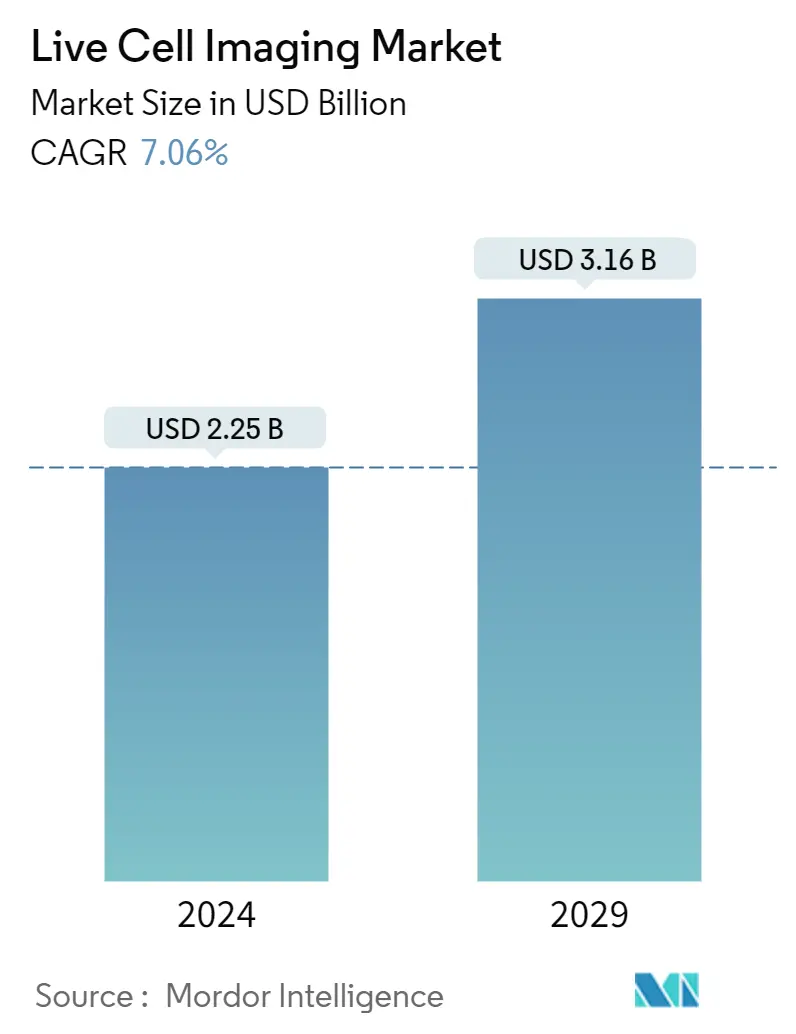Market Size of Live Cell Imaging Industry

| Study Period | 2019 - 2029 |
| Market Size (2024) | USD 2.25 Billion |
| Market Size (2029) | USD 3.16 Billion |
| CAGR (2024 - 2029) | 7.06 % |
| Fastest Growing Market | Asia-Pacific |
| Largest Market | North America |
| Market Concentration | Medium |
Major Players
*Disclaimer: Major Players sorted in no particular order |
Live Cell Imaging Market Analysis
The Live Cell Imaging Market size is estimated at USD 2.25 billion in 2024, and is expected to reach USD 3.16 billion by 2029, growing at a CAGR of 7.06% during the forecast period (2024-2029).
The COVID-19 pandemic had a severe impact on the market as there were supply chain disruptions due to the lockdown. However, the increasing demand for the early diagnosis of COVID-19 infection in order to develop an effective vaccination propelled the growth of the market as it led to increasing usage of the live cell imaging process. According to a research study published in Antiviral Research Journal in November 2021, a live-cell-based test for assessing the intracellular function of the CoV2 target, the Main 3C-like protease, was created, which is important and highly conserved (Mpro) and this method provided a high-throughput COVID-19 Main Protease (Mpro) screening system. The rising application of live-cell imaging in the identification of intracellular functions in COVID-19 led to increased adoption of live cell imaging and considerably impacted the market studied during the pandemic. Therefore, the increasing usage of live cell imaging equipment for the study of the molecular biology of the COVID-19 virus is expected to drive the growth of the market over the forecast period.
The growth of the live cell imaging market is attributed to the adoption of high-content screening techniques in drug discovery, the rising prevalence of chronic disease demanding higher and quicker diagnostic facilities, and government funding for cell-based research.
Live-cell imaging is a detection mode for cell-based assays and high-content screening techniques in drug discovery that helps in the identification of multiple measures of cell physiology, whether from sub-cellular compartments, multicellular structures, or model organisms. According to a study published in Frontiers in Cell and Developmental Biology in January 2021, high-content screening has aided in the comprehension of varied downstream effects for multiple treatments on cancer cells, specifically organelle targets, estimating the overall cellular response efficiently for new candidate molecules, and evaluating signaling heterogeneity. The rising advantages of high-content screening in understanding cancer cell response to novel drugs are expected to drive the adoption of the devices used for live cell imaging for the development of novel cancer treatments and fuel the overall market growth.
Besides, the development of innovative products is also contributing to market growth. For instance, in June 2021, Leica Microsystems launched the Leica Nano workflow, a new live-cell correlative light, and electron microscopy (CLEM) workflow solution designed to increase experimental success rates, improve reproducibility, and simplify light and electron microscopy (EM) integration. In addition, in January 2021, Zeiss Group launched the ZEISS Visioner 1, an innovative digital microscope for live-cell imaging that facilitates all-in-one focus in real-time through its Micro-mirror Array Lens System (MALS). This initiative is aimed at simplifying the imaging process and delivering higher throughput. Therefore, these developments in the market are predicted to garner the market's growth over the forecast period.
However, factors such as the high cost of high-content screening systems and the shortage of skilled professionals may hinder the growth of the market.
Live Cell Imaging Industry Segmentation
As per the scope of this report, live-cell imaging techniques allow the real-time examination of every aspect of cellular function under normal and experimental examinations. The Live Cell Imaging Market is Segmented by Product (Equipment, (Standalone Systems, Microscopes, Cell Analyzers, and Image Capturing Devices), Consumables (Reagents and Kits and Other Consumables), and Software and Services), Application (Cell Biology, Developmental Biology, Stem Cell Biology, Drug Discovery, and Other Applications), and Geography (North America, Europe, Asia-Pacific, Middle East and Africa, and South America). The market report also covers the estimated market sizes and trends of 17 countries across major regions globally. The report offers the market size in value terms in USD for all the abovementioned segments.
| By Product | ||||||
| ||||||
| ||||||
| Software and Services |
| By Application | |
| Cell Biology | |
| Developmental Biology | |
| Stem Cell Biology | |
| Drug Discovery | |
| Other Applications |
| Geography | ||||||||
| ||||||||
| ||||||||
| ||||||||
| ||||||||
|
Live Cell Imaging Market Size Summary
The live cell imaging market is poised for significant growth, driven by advancements in high-content screening techniques and increased applications in drug discovery and chronic disease diagnostics. The market's expansion is further supported by government funding for cell-based research and the development of innovative products, such as Leica Microsystems' live-cell correlative light and electron microscopy workflow and Zeiss Group's digital microscope. These technological advancements are enhancing the capabilities of live cell imaging, facilitating the study of cellular responses to novel treatments, particularly in cancer research. The market's growth trajectory is also influenced by the rising adoption of standalone systems, which offer independent functionality and are increasingly utilized in research and development. Collaborations, such as those between TGen and Deepcell, are leveraging artificial intelligence to advance the capabilities of live cell imaging, contributing to the market's dynamic evolution.
North America is a key region in the live cell imaging market, with a substantial share attributed to its robust research funding and a significant patient pool, particularly in the United States. The region's market growth is bolstered by the prevalence of chronic diseases and the presence of major market players who are actively engaging in strategic initiatives like mergers and acquisitions. The competitive landscape is marked by the activities of prominent companies such as Becton, Dickinson and Company, Zeiss Group, and Thermo Fisher Scientific, which are driving innovation and expanding their market presence. The introduction of new products, such as Nanolive's 3D Cell Explorer and Nikon Corporation's high-resolution imaging detector, underscores the ongoing advancements in live cell imaging technology. These developments are expected to sustain the market's growth momentum over the forecast period.
Live Cell Imaging Market Size - Table of Contents
-
1. MARKET DYNAMICS
-
1.1 Market Overview
-
1.2 Market Drivers
-
1.2.1 Adoption of High-content Screening Techniques in Drug Discovery
-
1.2.2 Rising Prevalence of Chronic Disease Demanding Higher and Quicker Diagnostic Facilities
-
1.2.3 Government Funding for Cell-based Research
-
-
1.3 Market Restraints
-
1.3.1 High Cost of High-content Screening Systems
-
1.3.2 Shortage of Skilled Professionals
-
-
1.4 Porter's Five Forces Analysis
-
1.4.1 Bargaining Power of Suppliers
-
1.4.2 Bargaining Power of Buyers
-
1.4.3 Threat of New Entrants
-
1.4.4 Threat of Substitute Products/Services
-
1.4.5 Intensity of Competitive Rivalry
-
-
-
2. MARKET SEGMENTATION (Market Size by Value - USD million)
-
2.1 By Product
-
2.1.1 Equipment
-
2.1.1.1 Standalone Systems
-
2.1.1.2 Microscopes
-
2.1.1.3 Cell Analyzers
-
2.1.1.4 Image Capturing Devices
-
-
2.1.2 Consumables
-
2.1.2.1 Reagents and Kits
-
2.1.2.2 Other Consumables
-
-
2.1.3 Software and Services
-
-
2.2 By Application
-
2.2.1 Cell Biology
-
2.2.2 Developmental Biology
-
2.2.3 Stem Cell Biology
-
2.2.4 Drug Discovery
-
2.2.5 Other Applications
-
-
2.3 Geography
-
2.3.1 North America
-
2.3.1.1 United States
-
2.3.1.2 Canada
-
2.3.1.3 Mexico
-
-
2.3.2 Europe
-
2.3.2.1 Germany
-
2.3.2.2 United Kingdom
-
2.3.2.3 France
-
2.3.2.4 Italy
-
2.3.2.5 Spain
-
2.3.2.6 Rest of Europe
-
-
2.3.3 Asia-Pacific
-
2.3.3.1 China
-
2.3.3.2 Japan
-
2.3.3.3 India
-
2.3.3.4 Australia
-
2.3.3.5 South Korea
-
2.3.3.6 Rest of Asia-Pacific
-
-
2.3.4 Middle East and Africa
-
2.3.4.1 GCC
-
2.3.4.2 South Africa
-
2.3.4.3 Rest of Middle East and Africa
-
-
2.3.5 South America
-
2.3.5.1 Brazil
-
2.3.5.2 Argentina
-
2.3.5.3 Rest of South America
-
-
-
Live Cell Imaging Market Size FAQs
How big is the Live Cell Imaging Market?
The Live Cell Imaging Market size is expected to reach USD 2.25 billion in 2024 and grow at a CAGR of 7.06% to reach USD 3.16 billion by 2029.
What is the current Live Cell Imaging Market size?
In 2024, the Live Cell Imaging Market size is expected to reach USD 2.25 billion.

